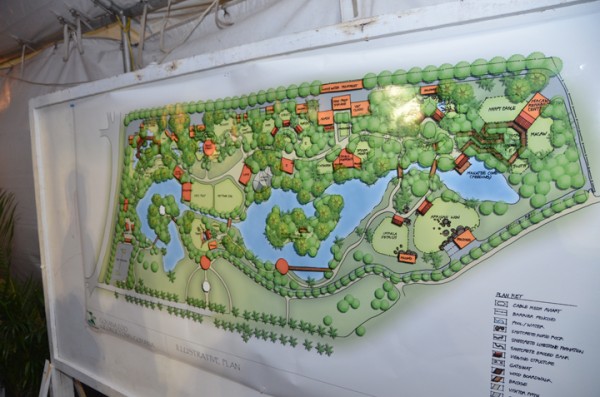The Master Plan for the Zoological Park was unveiled on Tuesday night and while no deadlines or project costs have been set, Minister of Natural Resources Robert Persaud said that the government has already committed $150 million.
The plan, launched under the Three Parks Initiative by the Protected Areas Com-mission (PAC) in partnership with the Beharry Group, was conceptualised by PJA Architects and envisages the creation of five habitats aimed at depicting Guyana’s biodiversity, including a rainforest walk through and a savannah. The plan also envisages Asian and African exhibits, but the first project to be tackled will be the rehabilitation of the manatee pond. It is not only the animal exhibits that will benefit but also restoration is planned for original Dutch kokers throughout the park.

Persaud told Stabroek News that the master plan is not just about talk as already the Mexican Ambassador has promised technical support. He noted also that a million dollars was pledged by a representative of Caribbean Chemicals, the company which originally had a stake in the rejuvenation of the Zoological Park in 1997.
Persaud also said that wildlife exporters and exchange programmes were already willing to discuss a lasting relationship with Guyana when the project kicks off and the various habitats created. He said that “we are not going to get people to write us cheques but we are interested in them coming and embracing and then also adopting and implementing with us… we aren’t going on a fundraising drive but rather we are going on a drive where people take ownership.”
Persaud noted that the waters were being tested but that it was his hope that the rehabilitation would commence shortly.
He said that connecting Guyanese with the biodiversity that is in abundance could increase the accountability in preserving the environment. “I urge persons to stop littering; we have been working with the rotary clubs and other groups to develop these facilities for children,” he said, while adding that the rehabilitation of the zoo was to get all stakeholders and potential stakeholders vested in the care of the environment.
Jim Brighton, on behalf of the PJA Architects, which will be providing all services pro bono, said that zoos had the ability to bring rural beauty to urban dwellings, allowing citizens to see what their country has to offer. He added that the master plan, which was finalised just over a month ago, was inclusive of an access road which would allow for continuous rehabilitation work to be ongoing. He said that to have a timeline for completion was unrealistic because donations and funding were not guaranteed or steady. Brighton mentioned that the Seattle Zoo had a master plan in effect since 1972 that was ongoing. He mentioned that the rehabilitation had to work like a giant puzzle, with pieces coming together one by one.
Meanwhile, PAC Com-missioner Damien Fernandes stated that as work would commence of assembling a modern zoo, the care of animals had to also be addressed. He said that currently 40 percent of the animals were brought in and needed rehabilitation.
He emphasised that the zoo is working with rehabilitation as a goal and that any exchange programmes had to make provisions for animal care.
Veterinarian Dr Steve Surujbally stated that he was extremely confident in the master plan and the project although it was without deadlines or costs established. He said, “Without timelines it will have to go piece by piece, they can’t get all the money at once.” He added that as former president of the Guyana Society for the Prevention of Cruelty to Animals, a zoological park was a teaching tool that was immeasurable and since 1997 there has been a desire to see the zoo transformed and animal care becoming a greater priority.





